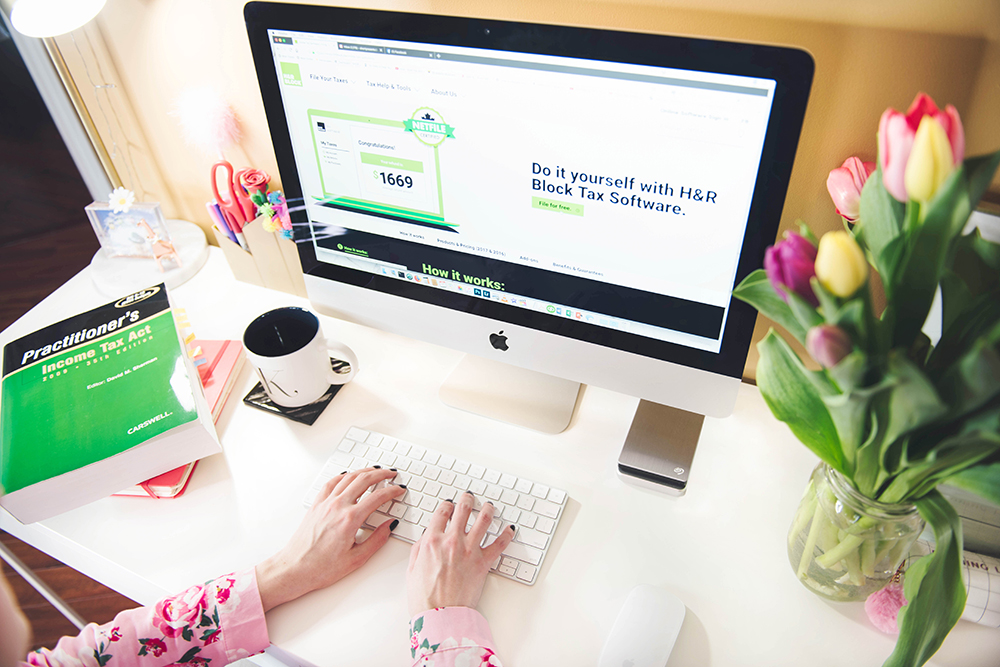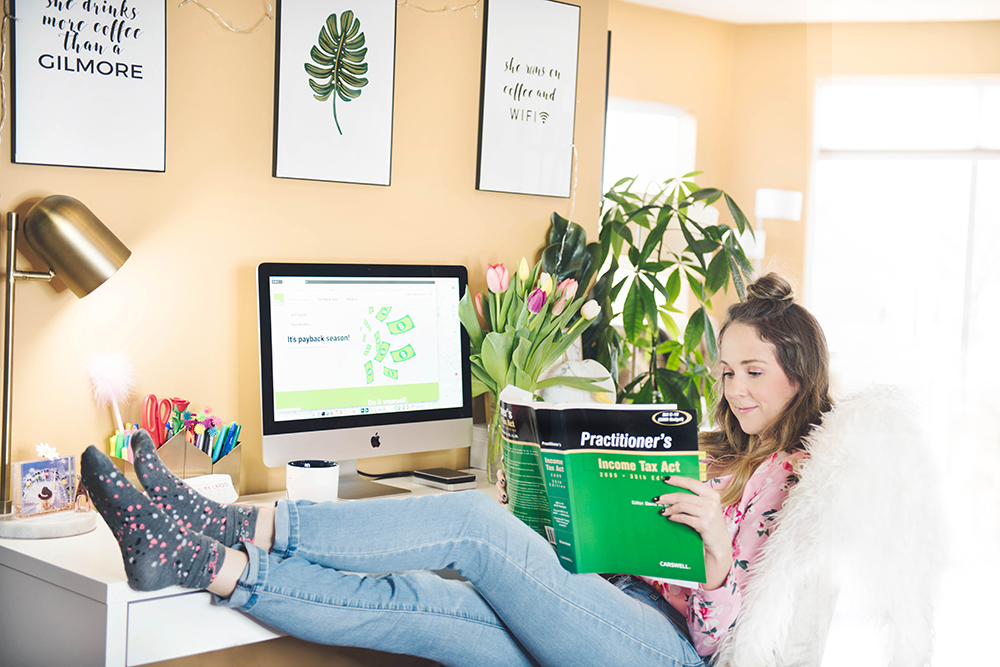Let’s talk about tax baby! Not everrrrrrrryone’s favorite subject, but let me tell you saving money definitely is, and if educating yourself a bit more about your taxes means more money in your pocket then it’s probably something we all should know a little more about.
Y’all might not know this, but my boyfriend is a Chartered Accountant (yep he’s a super smarty pants), and I’m super lucky because we talk about this kind of stuff all the time. I’m forever asking, hey can I claim this? And he usually says no. lol
When it comes to taxes we all wish we had an accountant at our fingertips, and with the H&R Block Online Tax Software you pretty much do! With around-the-clock support, and filing at your fingertips it couldn’t be easier!
What I liked about using the H&R Block Online Tax Software:
There is a free version:
If your taxes are pretty straight forward you can file your taxes for free. I mean, you kinda can’t argue with FREE.
It gets the job done:
It might not be flashy, but the interface is clean, simple, and easy to navigate so no need for bells and whistles. The one downside is if you are self-employed because you’ll have to pay a little extra, but to be fair our taxes are more complicated so it makes sense.
Switching is easy:
I know when I was thinking about using the H&R Block online tool I was worried about how all my stuff would transfer over (especially for anyone who has carry forward credits from university this can be very concerning! However, I’m here to tell you it’s quite simple.
The tax software allows you to import data from competitive software with one click. So, no need to worry if you filed with a different online service last year.
*As a heads up though, the free version does not automatically import last year’s return.
Online chat support:
Users of all the paid packages do get free online technical chat support. You can also purchase their Expert Review service, so if at any time you’re not sure about something, you can chat with a professional, or have someone check your homework. This is especially helpful if it’s your first time filing online.
Helpful hints:
Sometimes I’m not really sure what can be claimed, and as a small business owner and blogger these lines get a little blurry, so I found the hints included in the software, to be very helpful when I just wasn’t sure.
There are also desktop & app versions available:
If you don’t want your taxes “living in the cloud”, you can also download a desktop version. I did not use the desktop version or the app, so I cannot speak to how it works, but I imagine it’s pretty similar.
Brick-and-mortar security blanket:
If you change your mind about filing online, you know there is always the option to seek advice in person at one of their brick-and-mortar locations in your area.
Tips to maximize your return:
Raise your hand if you want more money in your pocket?? When it comes to taxes it really comes down to the prep work and holding onto those receipts! Always remember if you don’t have proof you can’t claim it.
I’m sure there is probably something you could be doing that you’re not! A lot of times there are things you could be claiming, but just had no idea they qualified. As well, there are things you should be doing all year long to help maximize your return, and while it might be too late for you this year, I’ve included some suggestions you might want to consider for next year’s return.
Take advantage of RRSPs:
Canadians should try and take advantage of RRSPs each year where possible to help them achieve their financial goals, maximize refunds and prepare for the future. The RRSP contribution deadline is March 1 and is a chance for Canadians to review their finances and determine how much they can contribute to maximize their refund or minimize what they owe in income tax.
Claim eligible medical expenses:
If you received medical care this year or if a family member suffered from an illness or disability, find out whether those medical expenses can earn you a tax credit. For example, if you paid for hospital services, paid to live in a nursing home, or bought medical supplies such as pacemakers, prescription drugs, vaccines, or walking aids, you may be able to claim a non-refundable tax credit. Unfortunately, you can’t claim things like fitness club memberships and over the counter medication, even if they were prescribed by a doctor.
Don’t forget about your childcare expenses:
Be sure to claim all expenses and deductions you are entitled to as a family. If you paid for childcare, you may be able to claim it. Just make sure to keep receipts.
Transfer unused credits:
If you’re married or have a common-law partner, you can transfer a variety of unused tax credits — such as the pension income amount, age amount and disability amount — to your spouse or partner. There are also several credits for students that can be transferred to a spouse, parent or even grandparent if they don’t want to carry forward the unused amounts themselves. Parents, this means you can claim your child’s tuition amounts.
Be aware of tax changes that will affect this year’s return:
The government announced the elimination of the public transit credit on June 30, 2017. Though the credit ended mid-year, you can still claim a 15 per cent non-refundable tax credit for transit passes purchased between January 1 and June 30, 2017 on your 2017 income tax and benefit return.
In recognition of the commitment and sacrifice made by members of the Canadian Armed Forces, military salaries of all deployed Canadian Armed Forces personnel would be exempt from federal income taxes.
The Children’s Arts and Fitness tax credit is no longer be available, which came into effect January 1, 2017.
Know the rules around business expenses (because you can’t claim everything in full):
Δ Home Expenses: If you’re using your home as your principal place of business, you can claim a portion of your home expenses. Home expenses include insurance, property tax, mortgage interest, and utilities. The amount you can claim depends on the percentage of the total square footage of your home that you use for your home office. However, if you do not use the office exclusively for business, you’ll have to further reduce it by the percentage of time you use it for personal use.
Δ Outfits/clothing expenses: The CRA will not allow you to claim clothing as an expense unless you use it exclusively for business use (for example, costumes which you would not have any personal use of).
Δ Equipment expenses: Computers, cell phones and other such equipment are capital assets. As such, you cannot deduct the entire expense in the year of purchase. Instead you can claim capital cost allowance, which means you can claim a percentage of the cost each year. For computers this is 55%, although you can only claim half the regular amount in the year of purchase. With respect to your cell phone, you can deduct the percentage of air-time expenses that relates to your business income.
Δ Travel expenses: You can claim travel expenses (flights, ground transportation, hotels) if it is reasonable but you cannot claim any part of your travel expenses that are personal in nature. You always need proof that you generated income or it was integral/beneficial to your business as a result of the travel expense. For example, prove that you attended a workshop or a conference, not that you took Instagram photos while at the beach.
Bottom line, when it comes to taxes you need proof, proof, and more proof. Think of it like your old term papers, if you don’t have a source to credit it’s basically void. And the more organized you are all year the easier it’ll be when it comes to tax time. I find having one place to put everything really helps keep me organized, and there are lots of programs now that you can keep track of expenses digitally! Don’t put it off until the last minute because it will stress you out, and you’re going to hate the thought of doing it. Taxes are a fact of life, and unfortunately you can’t avoid them, but if you get ahead of it, and prepare yourself: it doesn’t need to be so bad.
Hope you found today’s post helpful! And hopefully it’ll even save you some money too.
xx
Kayla
This post was sponsored by H&R block; however all opinions expressed are my own.








2 Comments
Great tips – I find it intimidating to try to decide what expenses to claim, especially as a VERY small solo business. Thanks!
I hear ya!! Travis made me an excel spreadsheet and included links for verification Ive been telling him he needs to make it available to other small biz people and bloggers!